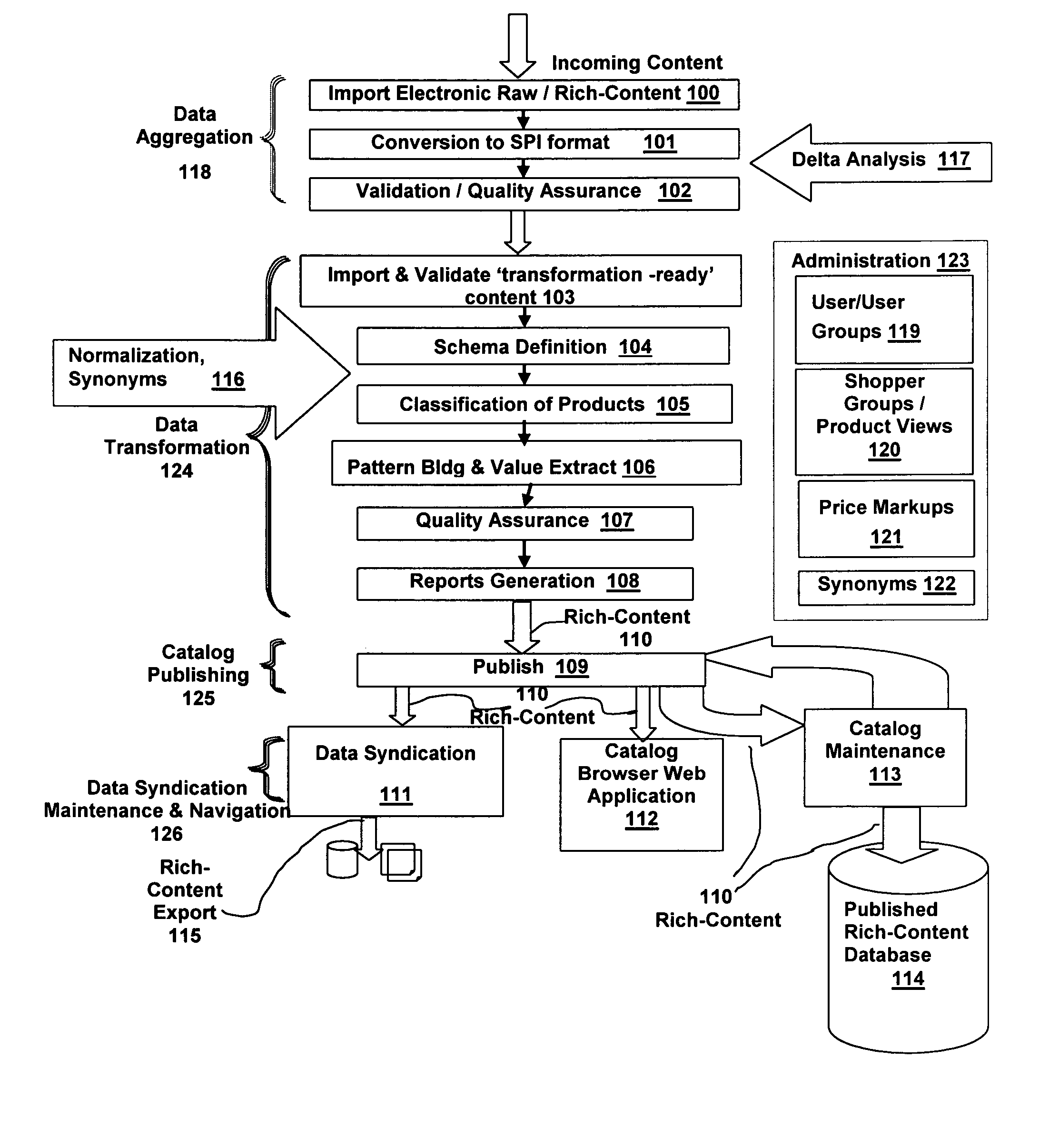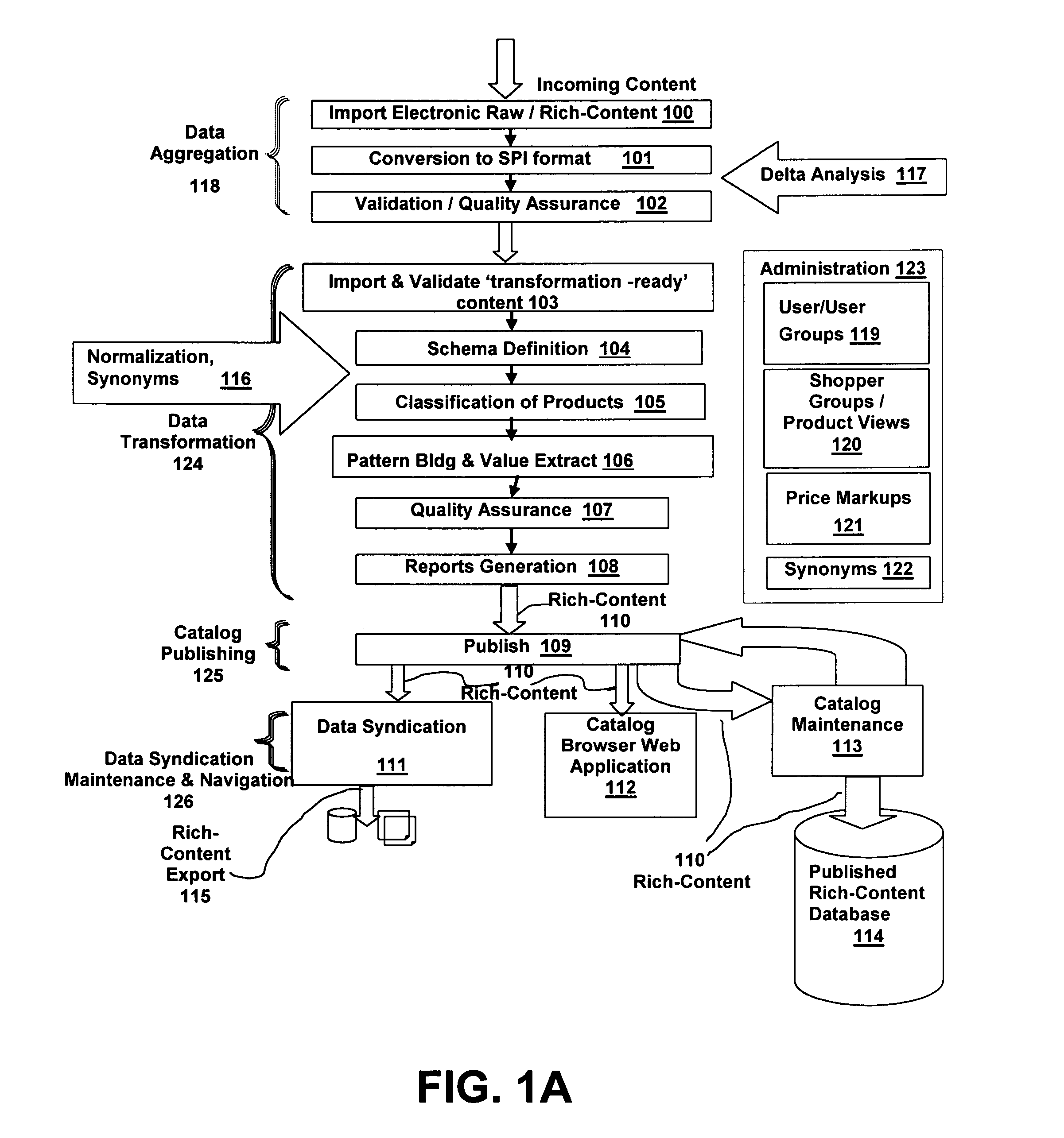[0023] Thus, there is a need for a customizable end-to-end or life-cycle system and method, which Users dynamically customize and functionally enhance and then employ to create and manage a rich-content repository of product / supplier data of the highest possible quality. The present invention provides such a system and method in which Users can adapt to and reflect the descriptive nuances of products available from individual suppliers. The life-cycle system and method of the present invention relates rich-content to industry standards and to supplier and buyer business practices, in order to provide a satisfactory search in a procurement setting. In the life-cycle of a system and method according to the present invention, a User finds what is wanted, is able to compare (1) attributes, (2) vendor terms and conditions, (3) prices, (4) availability, (5) options, and (6) replacement parts, to verify contract terms and conditions as well as all other details related to the product or vendor, and to verify that the goals of a procuring organization are not compromised.
[0045] The present invention also provides at least one User-defined function that extends the associated standard set of functions of the at least one life-cycle stage. That is, in addition to a User-defined life-cycle having at least
one stage, the system and method of the present invention provides the capability for definition of additional User-defined functions associated with each life-cycle stage. These additional User-defined functions are for capturing
subject matter expert intelligence and implementing the dynamic customizations that are required by rich-content Users. These capabilities are needed for facilitating conversion of “data” into “actionable information” and responses to the
continuous data modifications that are required to meet ever-changing requirements for receiving, using, and syndicating rich-content.
[0047] These User-defined capabilities allow a User to select data manipulation decisions that have to be made, to easily direct a rich-content system to make these complex data manipulations automatically, and to define stages to include notification of the User on an “exception basis” when further manual intervention is needed.
[0050] 1. User-defined “smart fields” are provided in a content system and method to intelligently and dynamically control the rich-content life-cycle of inputting,
processing and outputting rich-content information that requires unique treatment. The smart fields implement User-defined rules that define fields that are mandatory,
field data types, fields that are interdependent with the values in other fields, default values for empty but required fields, and fields that require validation. To ensure field value validation, the smart fields force entered data to match User-controlled meta-
data field values. To implement field value conditionality, the smart fields utilize an “expression builder” to dynamically determine computed input values for User-defined fields. This aspect of smart fields enables the User to integrate into a simple or complex expression: the values in already defined or standard fields, string or numeric constants, and the basic numeric functions (+−* / ). The smart field expression can be used to dynamically manage field-related events, values and relationships, including: creating a desired field value, modifying a field attribute, establishing field interdependencies, triggering event notifications to selected uses, and sending
process control messages to workflows.
[0057] 8. Refinement of item classification and item retrieval is provided by a function to subdivide generated class patterns by attribute name. This function allows Users to apply Global Level
pattern matching rules (a
library of Patterns) that are common to all types of rich-content items that share at least one characteristic. As an example, where size is described as a fractional number or a decimal Users may “Call” all existing fractional size patterns stored in the system to read the incoming data as non standardized input and find the correlating size within the descriptive text information and interpret it and create a standardized output based on the global level pattern. This function mitigates two main issues Users face in data
standardization. First, the repetitive processes of finding data elements and converting them to a standard are captured as knowledge-based
pattern matching rules that can be reused. Second, the function imposes
standardization across multiple rich-content items that facilitates the comparison of
cross matching items from multiple sources.
[0067] A typical ePlatform comprising a rich-content system according to the present invention can also provide a private marketplace that can be tailored to specific buyer needs, allowing contracted items / prices in separated views within the same marketplace, which reduces maverick buying (unauthorized purchases of products / services including products / services not included in the rich-content system).
 Login to View More
Login to View More  Login to View More
Login to View More 


